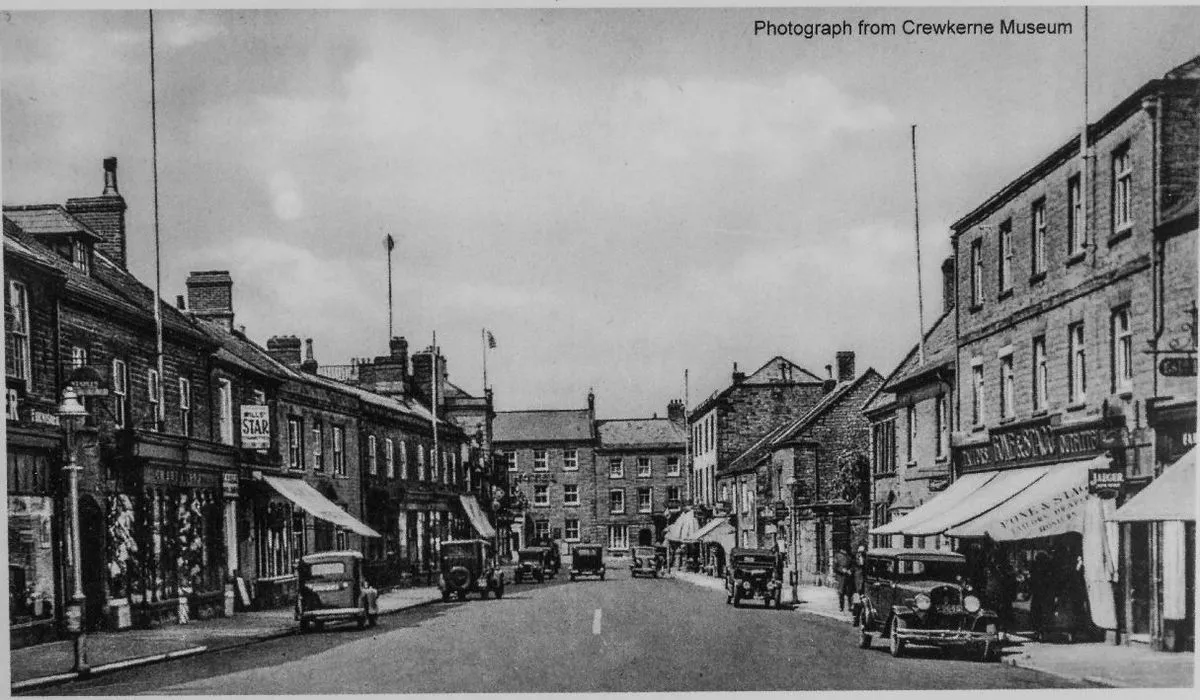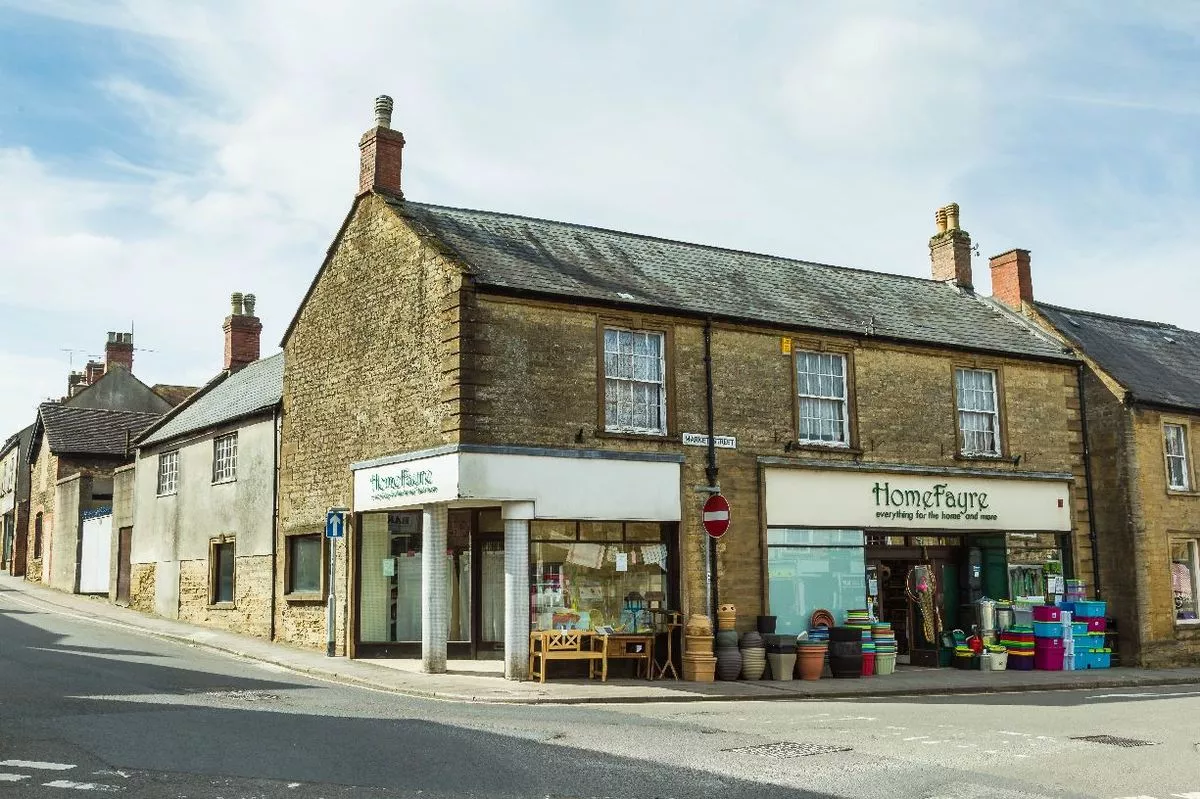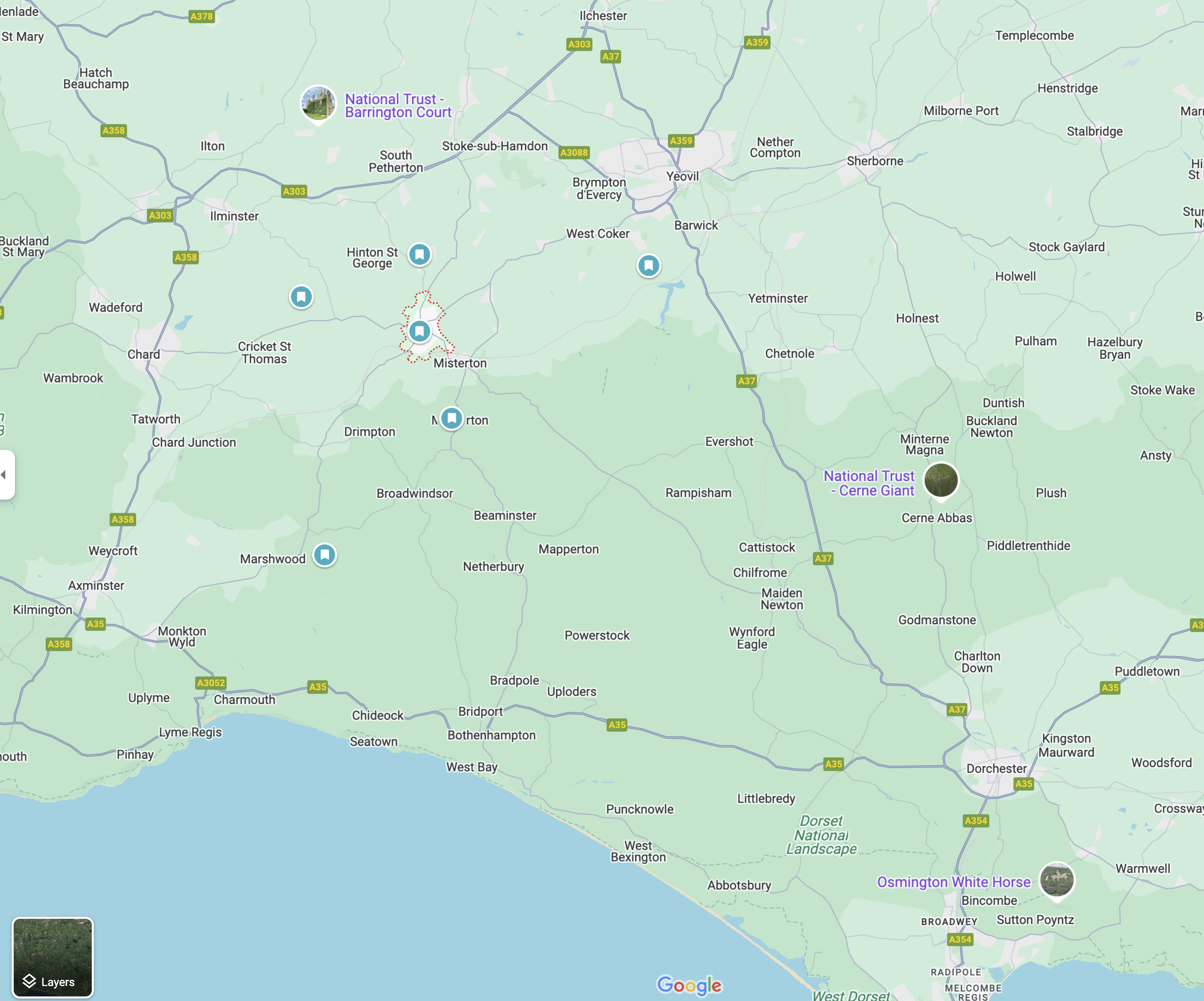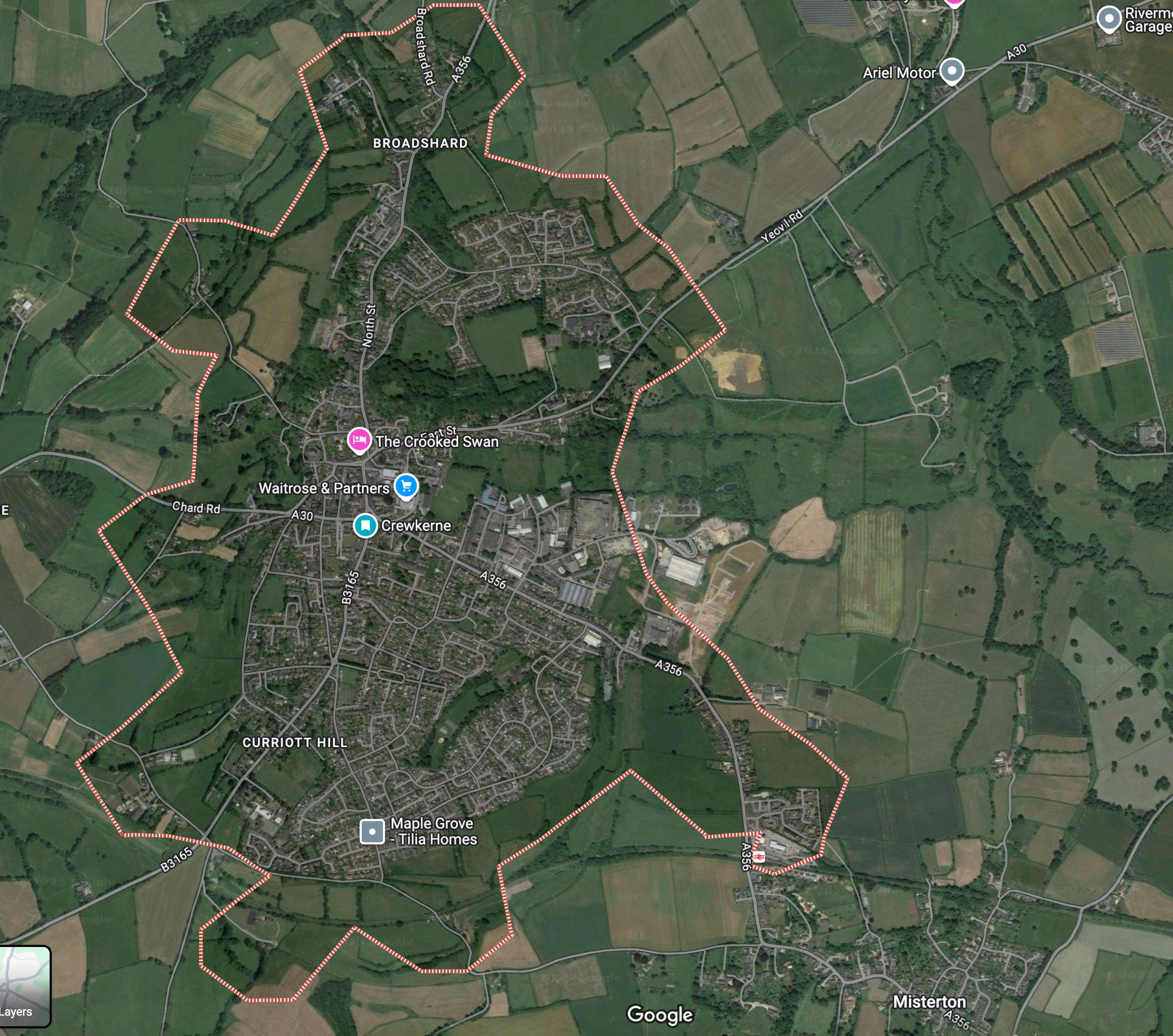If you're curious on the methodology 1. Get raw information about sources that document key aspects of life. (Check other personal sources... of which there were none) 2. Transcribe and internalize the 45 sources documenting his life in records (22k tokens turned into a 9k token document) 3. use the documentation to do a deep research and focus on history of locations and what happened with his family
Edward Bargery: A Somerset Life (1831–1862)
 How Market Street in Crewkerne used to look
How Market Street in Crewkerne used to look
His time predates photography and there are no paintings. In fact his town has very little imagery from his time. This was one of the oldest from the town
 Modern image of town
Modern image of town
 Map of modern surroundings
Map of modern surroundings

Early Life and Family in Crewkerne
Edward Bargery was born in 1831 in Crewkerne, Somerset, England (Edward Bargery Family History Records - Ancestry®). He was the son of William Bargery and Mary (Hopkins) Bargery, a working-class couple in this rural market town. Edward’s parents had married on 31 January 1820 at St. Bartholomew’s Church in Crewkerne (Mary Hopkins (1795–before 1861) - Ancestors Family Search) (Show Posts - Eyesee - RootsChat). They went on to have a large family. Church and civil records indicate Edward had multiple siblings, though not all survived infancy. Among his sisters were Matilda Bargery (born 1825) and Eliza Bargery (born c.1829) (Mary Hopkins (1795–before 1861) - Ancestors Family Search). An elder sister, Caroline Martha, born in 1822, died as an infant (Mary Hopkins (1795–before 1861) - Ancestors Family Search). Another baby sister, Ann (or Emily) Bargery, was born and died in 1836 (Mary Hopkins (1795–before 1861) - Ancestors Family Search). Edward also had two elder brothers named William – one born in 1816 who died as a child in 1824, and another born in 1821 who died in infancy (Mary Hopkins (1795–before 1861) - Ancestors Family Search). Edward was one of the younger children; an “Emma Bargery” born in late 1835 appears with Mary in the 1851 census, suggesting Edward had a sister Emma as well (Emma Bargery (1835–1901) • FamilySearch) (this may correspond to the “Emily” who died young). In all, Mary Hopkins Bargery bore at least eight children, of whom Edward and a few sisters reached adulthood (Mary Hopkins (1795–before 1861) - Ancestors Family Search).
Edward’s father, William Bargery, worked as a labourer, typical of many Crewkerne men (Bettiscombe Marriages 1732-1921 Parish Registers - Dorset OPC). The family likely lived modestly. In the 1841 census, William and Mary Bargery can be found in Crewkerne with some of their children (Mary is listed in William’s household) (Mary Hopkins (1795–before 1861) - Ancestors Family Search). By 1851, Edward (around 19) might have been employed away from home, as large families often sent teenage children to work. His mother Mary was originally from East Coker (a village nearby in Somerset) (Mary Borgrey Individual Records - Ancestry®), and she likely imparted strong religious and practical values – the Bargery children were baptized in the local Anglican parish (St. Bartholomew’s). The family’s daily life would have revolved around William’s earnings as an agricultural or manual laborer and Mary’s domestic work raising the children. They lived during a time of rapid population growth in Crewkerne – the town’s population doubled in the first half of the 1800s (2,567 people in 1801 to about 5,000 by mid-century) (Crewkerne History | Crewkerne Museum - Somerset) – which suggests a bustling community but also fierce competition for jobs and housing among the working poor.
Tragedy struck the Bargery family more than once. Several of Edward’s siblings died young, and Edward himself would have grown up attending tiny graveside funerals. In 1841, his 12-year-old sister Eliza passed away (Mary Hopkins (1795–before 1861) - Ancestors Family Search). These losses were not uncommon in an era of high childhood mortality. Such experiences likely bonded the surviving siblings closely. Edward’s sister Matilda Bargery survived and later emigrated to Australia (she died in 1903 in Victoria) (Matilda (Bargery) Barter (1826-1903) | WikiTree FREE Family Tree) (Matilda (Bargery) Barter (1826-1903) | WikiTree FREE Family Tree), and another sister (possibly Emma) lived into adulthood (Emma Bargery (1835–1901) • FamilySearch). Edward’s mother Mary Bargery died sometime before 1861 (Mary Borgrey Individual Records - Ancestry®), and his father William died in January 1858 at about 58 years old (William Bargery (abt.1798-1858) | WikiTree FREE Family Tree), when Edward was in his late twenties. Thus, by the early 1860s Edward and his siblings had lost both parents. This was the family background that shaped Edward’s youth: a large, modest household navigating the hardships of 19th-century rural England.
Marriage to Eliza Spurdle and Children
In the summer of 1854, at about 23 years of age, Edward Bargery married Eliza Spurdle, a Dorset native. The marriage took place on 6 August 1854 in the parish church of Bettiscombe, Dorset, a small village just over the county border (Eliza Spurdle (1823–1909) - Ancestors Family Search). A parish register transcription of the event provides valuable details: Edward, a bachelor “of full age,” was recorded as a labourer residing in Bettiscombe at the time, and he listed his father as William Bargery, labourer (Bettiscombe Marriages 1732-1921 Parish Registers - Dorset OPC). The bride, Eliza Spurdle (age 30 in 1854, so a few years older than Edward), was a spinster from Bettiscombe; her father was John Spurdle, also a labourer (Bettiscombe Marriages 1732-1921 Parish Registers - Dorset OPC). The marriage was by banns, indicating both were of the Anglican faith then. It’s likely Edward had moved the few miles to Bettiscombe for work opportunities, which is how he met Eliza. Eliza herself was born in Bettiscombe in 1823 (Eliza Spurdle (1823–1909) - Ancestors Family Search), so this was her home parish.
After their marriage, Edward and Eliza settled back in Crewkerne where they started their family. They had four known children. Their first child, Elizabeth Bargery, was born on 21 October 1854 in Crewkerne (Elizabeth Bargery (1854–1873) • FamilySearch) – coming just a couple months after the wedding (possibly she was conceived out of wedlock or very shortly after marriage, which was not uncommon and carried less stigma by mid-19th century). Next came a son, John Alfred Bargery, born 9 December 1857 in Crewkerne (John Alfred Bargery (1857–1912) • FamilySearch). A third child, Johana Bargery, was born in 1861 but sadly died as an infant that same year (John Alfred Bargery (1857–1912) • FamilySearch). Finally, Eliza was pregnant with their last child when tragedy struck: Mary Jane Bargery was born on 20 October 1862 (Profile: Mary Jane Bargery Gill 1862-1948 - (Deep Family History Research) — Hive), eight months after Edward’s death. Mary Jane would never meet her father, yet she would carry forward the Bargery legacy into the next century.
The Bargery children’s early years were spent in Crewkerne. The 1861 England census captures a snapshot of the family shortly before Edward’s passing. In that census, Edward Bargary, 30, is listed as head of household in Crewkerne, with wife Eliza, 38, and children Elizabeth, 6 and John, 3 (baby Johana likely had died by the census) (Eliza Spurdle (1823–1909) - Ancestors Family Search). Eliza’s occupation in 1861 was recorded as “glove maker” (Eliza Spurdle (1823–1909) - Ancestors Family Search), reflecting the local cottage industry of glove-sewing (Crewkerne is near Yeovil, a center of glove manufacturing). Edward’s occupation in 1861 isn’t explicitly quoted in the surviving snippet, but given his history it was likely still “labourer” – possibly an agricultural labourer or a mill-hand. Family recollections and documents describe Edward Bargery as an “agricultural laborer”, working in the fields or doing general work, which was typical for Crewkerne residents of his class (Profile: Mary Jane Bargery Gill 1862-1948 - (Deep Family History Research) — Hive). His life as a husband and father would have been defined by hard work to provide for Eliza and the children. They lived humbly, perhaps in a cottage on the outskirts of town or near one of the factories or farms.
Sadly, Edward’s time to raise his family was cut short. He died on 25 February 1862 in Crewkerne (Edward Bargery Family History Records - Ancestry®), only 30 or 31 years old. It’s not recorded what the cause was – possibilities range from a sudden illness (such as tuberculosis or cholera, both common killers in that era) to a work accident. His burial was likely at the parish church of Crewkerne (St. Bartholomew’s), where a burial register entry would mark the interment of “Edward Bargery of Crewkerne, age 30.” His death left Eliza widowed with very young children – Elizabeth was 7, John 4, and Eliza was expecting Mary Jane. One can imagine the precarious situation for the Bargery family: a pregnant widow with limited means and two little ones, mourning the loss of their father. They probably received support from extended family or the parish. Notably, Eliza did not remarry while in England; instead, a profound change was on the horizon for her and the children in the years following Edward’s death.
Crewkerne in Edward’s Time: Work and Community
To better understand Edward Bargery’s life, it’s important to know the historical environment of Crewkerne in the early-to-mid 19th century. Crewkerne was a small market town in southwest Somerset. During Edward’s lifetime, the town was experiencing the effects of the Industrial Revolution mixed with traditional rural life. Crewkerne had long been a center of textile production, particularly known for heavy canvas and webbing. In fact, throughout the 18th and early 19th centuries the main industry was cloth-making, including manufacturing webbing and sailcloth for the Royal Navy (Crewkerne - Wikipedia). The Napoleonic Wars (1790s–1815) had spurred a boom in sailcloth—local lore even holds that Crewkerne canvas was used for the sails on Admiral Nelson’s HMS Victory. By 1828, 27 sailcloth firms operated in the Crewkerne area, and by 1851 roughly 22% of Crewkerne’s workforce was employed in sailcloth manufacture (Crewkerne History | Crewkerne Museum - Somerset). This boom created jobs and prosperity for some, and the first half of the 19th century saw rapid population growth and building in the town (Crewkerne History | Crewkerne Museum - Somerset). Many of the brick and stone houses and shops lining Crewkerne’s streets today date from that Georgian and early Victorian expansion, when factories and the homes of mill-owners were erected (Crewkerne History | Crewkerne Museum - Somerset).
However, most of these industrial jobs were labor-intensive and low-paying, especially for those at the bottom. The sailcloth and webbing factories often began as family firms that grew into larger operations; some powered their looms with water from the River Parrett’s tributaries (Crewkerne History | Crewkerne Museum - Somerset). Even as factories rose, much work remained cottage industry: weaving and glove-sewing done at home. We know that Edward’s wife Eliza was part of the glove trade, sewing gloves in 1861 (Profile: Mary Jane Bargery Gill 1862-1948 - (Deep Family History Research) — Hive) (Eliza Spurdle (1823–1909) - Ancestors Family Search). Glove-making was common in the Crewkerne/Yeovil area and often done by women to supplement the family income. Edward himself, described as a “labourer,” likely did a variety of work. Agricultural labor would have been seasonal – planting and harvest time could employ many extra hands on local farms. In other months, a labourer like Edward might find work hauling goods, tending livestock, or laboring at a flax mill or sailcloth workshop. Being a general labourer in Victorian England meant long hours (10+ hours a day) of physically demanding work for minimal wages. Crewkerne’s laborers were not highly paid; in the 1850s farm workers in Somerset earned only around 8–10 shillings per week, which barely kept a family fed. This was the class Edward was born into and lived in – the rural working poor.
Labor conditions in the 1830s–1850s oscillated between full employment during boom times and hardship during downturns. When Edward was an infant, the Swing Riots of 1830 (agricultural laborer protests) swept southern England – Somerset included – indicating how desperate farm workers were for a living wage. We have no record of William or Mary Bargery’s direct involvement, but such events were part of the social backdrop. The New Poor Law of 1834 created the Crewkerne Poor Law Union, and a workhouse was built in the area. It’s quite possible some extended Bargery relatives spent time in the workhouse during bad years. Community life for families like the Bargerys revolved around the parish church (for rites of passage and Sunday worship) and the markets. Crewkerne’s historic weekly market and annual fairs would have been important occasions. Mary Bargery might have sold homemade goods or produce there, and young Edward would have seen the town come alive on market days with farmers, livestock, and peddlers filling Market Square.
Religiously, Crewkerne was predominantly Anglican (Church of England) in Edward’s youth, but Nonconformist chapels also existed. By the mid-19th century, the town had active Baptist and Wesleyan Methodist congregations (Thirsty : 2015 Winter : THE DISAPPEARING SUGAR-BASINS - Part I). Later, Latter-day Saint (Mormon) missionaries also preached in Somerset. In fact, Crewkerne eventually had its own small LDS branch by the 1850s–60s (MP:Crewkerne Branch - Mormon Places). This religious ferment meant that by the time Edward reached adulthood, he woul